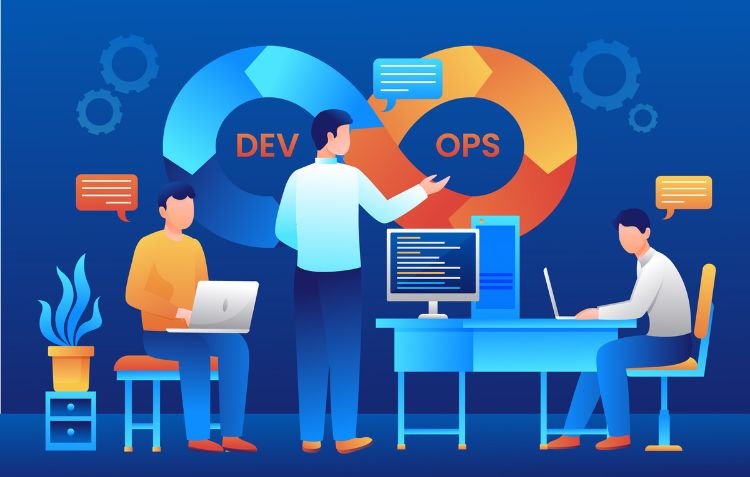Essential Co-Development Software Trends You Can’t Ignore in 2025
Software development is evolving at an unprecedented pace. Traditional, isolated approaches are no longer sufficient to meet the growing complexity and demand for rapid innovation. Businesses and development teams now rely on co-development software to collaborate seamlessly, whether working across different locations or within the same organization.
Co-development software refers to platforms that enable multiple teams, companies, or individuals to work together on a single project, streamlining development cycles, improving efficiency, and reducing costs. Organizations can build robust and scalable solutions faster than ever by leveraging cloud-based collaboration tools, AI-driven development environments, and open-source contributions.
As we move into 2025, new trends in co-development software are reshaping the industry. From AI-powered coding assistants to low-code/no-code platforms, these advancements are revolutionizing how software is built. In this article, we’ll explore the key trends driving co-development forward and how businesses can stay ahead in this dynamic landscape.
The Rise of Co-Development Software in 2025
The demand for co-development software is surging as businesses seek more efficient, collaborative, and cost-effective ways to build software. With growing project complexities, organizations can no longer afford isolated development models. Instead, they are embracing tools that foster seamless collaboration across teams, geographies, and industries.
In 2025, co-development software is at the forefront of innovation, leveraging AI-driven platforms, cloud-based environments, and real-time collaborative coding. Companies adopting these solutions benefit from enhanced efficiency, accelerated product cycles, and reduced development costs. The shift toward open-source collaboration, low-code/no-code platforms, and cloud-native development is driving widespread adoption.
Evolution of Collaborative Development
Historical Context
Traditionally, software development followed waterfall or siloed development models, where teams worked in isolation, leading to inefficiencies, delays, and communication gaps. Without real-time collaboration, iteration cycles were slow, and integrating different components often resulted in compatibility issues.
Modern Collaborative Needs
Today, software projects involve multiple teams working across different locations, requiring real-time communication, cloud-based version control, and AI-powered development tools. To meet growing demands, businesses now prioritize collaborative DevOps, open-source frameworks, and cross-functional teams, ensuring faster delivery and high-quality solutions.
Benefits Driving Adoption
Accelerated Innovation
Co-development software enables diverse teams to pool their expertise, leading to faster problem-solving and cutting-edge innovation. Open-source collaboration and AI-driven code suggestions further enhance productivity, allowing developers to build better solutions in less time.
Cost Efficiency
By sharing infrastructure, tools, and expertise, businesses can significantly reduce software development costs. Cloud-based co-development environments eliminate the need for expensive on-premise setups, making software creation more accessible to startups and enterprises alike.
Risk Mitigation
Collaborative development distributes risk by ensuring continuous code review, shared accountability, and automated security checks. This approach leads to more robust software, minimizing vulnerabilities and reducing deployment failures.
Key Co-Development Software Trends in 2025
The software development landscape is evolving rapidly, with co-development software playing a crucial role in fostering collaboration, efficiency, and security. As businesses seek to accelerate innovation while optimizing resources, new trends are emerging that reshape how teams build software together.
In 2025, key advancements in low-code/no-code platforms, AI-driven development tools, cloud-based collaboration, open-source ecosystems, and DevSecOps integration are transforming the industry. These technologies empower organizations to develop software faster, enhance security, and streamline workflows across distributed teams.
Low-Code/No-Code Platforms
Democratizing Development
The rise of low-code/no-code platforms has revolutionized software development by enabling citizen developers—business analysts, product managers, and non-technical professionals—to build applications without extensive coding knowledge. These platforms use drag-and-drop interfaces, pre-built templates, and AI-assisted automation, making development more accessible and efficient.
Companies benefit by reducing dependency on traditional development teams, allowing IT professionals to focus on complex engineering tasks while business users handle workflow automation, app customization, and rapid prototyping. The demand for low-code development is expected to surge, with Gartner predicting that by 2025, 70% of new business applications will be built using low-code/no-code platforms.
Case Study: A Business Success Story
A great example of low-code success is Airbus, which adopted a low-code platform to improve internal workflows and streamline manufacturing operations. By leveraging Mendix, a low-code solution, Airbus reduced manual processes by 50% and accelerated application development from months to weeks. The platform enabled cross-functional teams to collaborate, automate data processing, and integrate real-time analytics, improving operational efficiency significantly.
AI-Driven Development Tools

Enhancing Productivity
AI-powered development tools are transforming the way software is written, tested, and deployed. AI-driven platforms like GitHub Copilot, Tabnine, and Amazon CodeWhisperer assist developers by suggesting code snippets, detecting vulnerabilities, and automating repetitive tasks.
These tools boost developer productivity, allowing teams to focus on higher-level problem-solving rather than writing boilerplate code. AI also enhances predictive analytics, helping engineers anticipate issues before they arise, reducing debugging time, and improving code quality.
Recent Research Insights
A 2024 study by McKinsey found that organizations integrating AI-assisted development tools experienced a 40% increase in coding efficiency and a 30% reduction in debugging time. Additionally, a Stack Overflow survey revealed that 75% of developers using AI-driven tools reported higher productivity and improved code accuracy.
Cloud-Based Collaborative Environments
Seamless Remote Collaboration
With the rise of remote work, cloud-based development environments have become essential for real-time collaboration. Platforms like GitHub Codespaces, JetBrains Space, and AWS Cloud9 enable developers to write, test, and deploy code from anywhere, eliminating the need for local setups.
Cloud-based tools offer automated version control, instant code synchronization, and containerized environments, ensuring seamless integration across global teams. These platforms enhance agility, allowing businesses to adapt quickly to evolving development needs.
Example: A Global Development Team’s Experience
A global e-commerce giant, Shopify, adopted cloud-based tools to support its distributed development teams. Using Google Cloud and GitHub Enterprise, Shopify enabled seamless code collaboration, automated testing, and secure deployments across multiple time zones. This approach reduced development bottlenecks, improved cross-team communication, and accelerated feature releases.
Open-Source Ecosystem Expansion
Community-Driven Innovation
The open-source software movement is expanding, with companies and developers contributing to community-driven projects at an unprecedented scale. Open-source collaboration promotes transparency, security, and innovation, allowing businesses to build on pre-existing frameworks rather than starting from scratch.
Organizations like Google, Microsoft, and Meta actively contribute to open-source projects, ensuring software development remains scalable, adaptable, and efficient. The rise of distributed version control (Git), containerization (Docker, Kubernetes), and AI-powered frameworks (TensorFlow, PyTorch) highlights the increasing reliance on open-source tools.
Data Point: Growth in Open-Source Contributions
According to GitHub’s 2024 State of the Octoverse Report, open-source contributions increased by 35% year-over-year, with over 90 million repositories now active on the platform. The report also highlighted that corporate open-source adoption grew by 50%, as more companies recognize the value of community-driven software development.
Integration of DevSecOps Practices
Security in the Development Lifecycle
With the growing threat of cyberattacks, integrating DevSecOps practices has become a priority. Unlike traditional security models that assess vulnerabilities late in the development cycle, DevSecOps integrates security checks at every stage—from code writing to deployment.
Automation tools like SonarQube, Snyk, and Aqua Security ensure that security vulnerabilities are detected early, reducing the risk of data breaches and compliance failures. This proactive approach improves software resilience, ensuring applications meet regulatory and security standards.
Case Study: A Company’s DevSecOps Implementation
A leading fintech company, Stripe, implemented DevSecOps practices to enhance the security of its payment processing software. By integrating automated security scanning, continuous compliance monitoring, and real-time threat detection, Stripe reduced security incidents by 60% and accelerated secure deployments by 40%.
Challenges in Co-Development and Strategies to Overcome Them

Software co-development offers significant benefits, including faster innovation and shared expertise, but it also presents various challenges that can hinder efficiency. Addressing these obstacles effectively is crucial for maximizing productivity and ensuring seamless collaboration.
This section explores key challenges in co-development and provides strategic solutions to help organizations mitigate risks and optimize workflows.
Communication Barriers
Cultural and Language Differences
Global software development teams often consist of professionals from diverse linguistic and cultural backgrounds. Differences in language proficiency, work ethics, and cultural expectations can lead to misunderstandings, misaligned goals, and inefficiencies in collaboration. Misinterpretation of requirements, varying approaches to problem-solving, and differences in feedback reception can further complicate teamwork, slowing down project progress.
Strategy: Implementing Standardized Communication Protocols
To overcome these challenges, organizations should establish clear communication protocols. Using standardized terminology, creating detailed documentation, and implementing structured communication workflows can enhance clarity. Collaborative tools like Slack, Microsoft Teams, and Notion help maintain transparency and ensure real-time synchronization. Regular cross-cultural training and team-building activities also promote inclusivity and better interpersonal relationships among team members.
Intellectual Property Concerns
Ownership and Rights Issues
Determining intellectual property (IP) ownership in co-development projects can be complex. When multiple entities contribute to a project, conflicts may arise regarding licensing, rights to derivative works, and commercialization of shared innovations. Without clear agreements, disputes over code ownership and profit-sharing can disrupt project momentum.
Strategy: Crafting Comprehensive Agreements
Organizations should develop detailed contracts specifying IP ownership, licensing terms, and profit-sharing mechanisms. Utilizing legal frameworks such as open-source licenses (MIT, GPL) or proprietary agreements can help define contributions and rights. Consulting legal experts and employing blockchain-based smart contracts for transparent record-keeping further ensures accountability and fair distribution of ownership.
Tool Compatibility Issues
Integrating Diverse Systems
Co-development teams often use a variety of development environments, version control systems, and deployment tools. Disparities in software stacks, programming languages, and frameworks can lead to inefficiencies, requiring manual adjustments and additional integration efforts. Compatibility issues between different cloud platforms, IDEs, and CI/CD pipelines may further hinder workflow consistency.
Strategy: Adopting Universal Standards
Standardizing development tools and protocols is essential for seamless integration. Encouraging teams to adopt cross-platform technologies (Docker, Kubernetes, and WebAssembly) and universal APIs can bridge the gap between different systems. Utilizing cloud-based development environments like GitHub Codespaces or AWS Cloud9 allows teams to work within a unified ecosystem, reducing compatibility friction. Implementing automation tools for API bridging and middleware solutions also enhances interoperability.
Conclusion
The evolution of co-development software is being driven by advancements in low-code/no-code platforms, AI-assisted development, cloud-based collaboration, open-source integration, and DevSecOps practices. However, addressing challenges like communication barriers, intellectual property concerns, and tool compatibility is critical for maximizing efficiency.
Organizations must evaluate their current development practices, assess gaps in collaboration efficiency, and integrate standardized protocols to mitigate potential obstacles. Investing in communication tools, legal frameworks, and automation-driven integration solutions will enhance productivity and ensure seamless cooperation across global teams.
Embracing a co-development approach enables businesses to stay ahead in an increasingly competitive landscape. By fostering transparency, leveraging emerging technologies, and prioritizing strategic alignment, organizations can harness the full potential of collaborative development, driving innovation and long-term growth.
FAQs
What is co-development software?
Co-development software enables multiple teams or organizations to collaboratively develop applications, sharing resources and expertise throughout the project lifecycle.
How does co-development differ from traditional outsourcing?
Unlike traditional outsourcing, where a project is handed off to an external team, co-development involves active collaboration between internal and external teams, with shared responsibilities and decision-making.
What are the benefits of using co-development software?
Co-development software fosters innovation through diverse expertise, accelerates development timelines, and reduces costs by sharing resources among partners.
What challenges might arise in co-development projects?
Common challenges include communication barriers due to cultural differences, intellectual property concerns, and tool compatibility issues among collaborating entities.
How can businesses ensure successful co-development partnerships?
Success in co-development requires clear communication protocols, comprehensive agreements outlining roles and IP rights, and the adoption of standardized tools to ensure compatibility.







